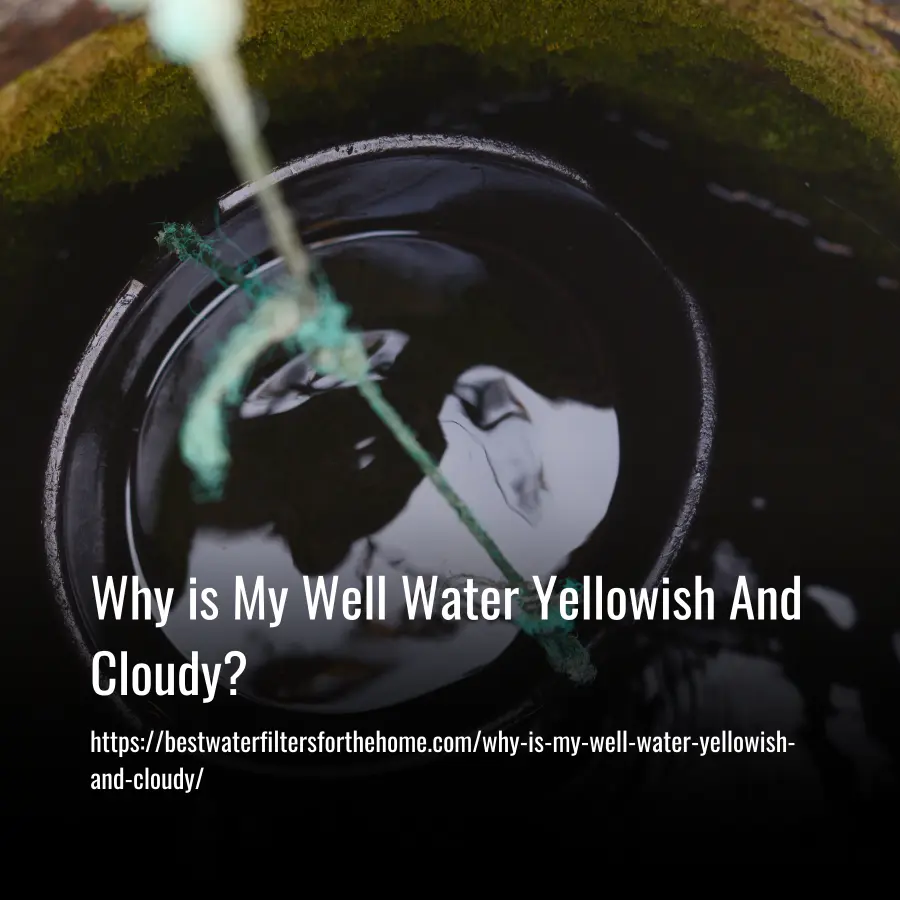This post contains affiliate links. As an Amazon Associate, we earn from qualifying purchases.
Well water is usually clear and clean, but sometimes it turns yellowish and cloudy. This happens because of many reasons including iron and manganese levels in the water.
If you notice any changes in your well watercolor, then you should check your iron and manganese levels and some other factors.
In this article, I’ll explain why your well water might be turning yellowish and cloudy and how to fix it.

Why is My Well Water Yellowish And Cloudy?
Well water isn’t supposed to be yellowish and cloudy. But if it does happen, there are several reasons why it might occur. Some of those reasons include:
1. Organic Materials
Well water that’s yellowish and cloudy isn’t necessarily bad. But if it smells bad, or tastes bad, then it probably needs to be treated before drinking it.
A lot of times, the reason your well water turns yellow is due to natural causes. Mother nature’s fermentation process produces by-products called tannins.
These tannins cause discoloring in the water and turn the water yellow. Luckily, tannins do no harm to humans, animals, or plants.
2. Iron Bacteria in Well Water
If your well water is yellowish and cloudy, there may be iron bacteria contaminating your well. You can test your well water for nitrates and coliform bacteria, which indicate if there is iron bacteria contamination.
3. Rust
Rust is one of the most common reasons why your water turns yellowish or cloudy. Rust is formed when iron combines with oxygen in the air. Over time, the iron oxidizes and forms a layer of rust on metal surfaces.
As long as there is no visible rust on your home’s pipes, then you shouldn’t worry about it. However, if you notice rust stains on your walls or floors, then you should contact a plumber immediately.
4. Ferric Iron
Ferric iron is a common contaminant that causes your well water to turn yellowish and clouded. Iron is a natural element that occurs on the earth.
Ferric iron is a form of iron that doesn’t dissolve in water and settles to the bottom of the well. As the iron settles, it forms a layer of sediment that turns your water yellowish and cloudy.
5. Rusty Pipes
Wells are usually located underground, so there’s no telling how long they’ve been sitting there. Old wells tend to leak, which causes the water inside to become contaminated. Over time, the iron in the water starts to corrode, turning the water yellow.
Rusty pipes are caused by corrosion. Corrosion occurs when metal reacts with oxygen or moisture in the air. Iron pipes are especially susceptible to corrosion since they contain lots of iron. Rust forms on the surface of the pipe and eventually leaks into the water supply.
6. Manganese Build Up
There are two main reasons why your well water turns yellow. First, iron and manganese are naturally occurring minerals that are present in groundwater supplies. These minerals cause your water to turn yellow.
Second, if your well isn’t properly maintained, it can become contaminated with bacteria and algae. Both of these factors can lead to discoloration of your water. While iron and manganese don’t pose any serious health risks, you should still try to fix the problem.
7. Rusty Water Heater
Rust can build up inside your water heater, causing discolored water. Your hot water supply could be affected by a small amount of rust that causes it to turn yellow, brown, or orange water.
8. Fire Hydrant Use
Your well water might turn yellowish and cloudy if you’re using a nearby hydrant during emergencies. Fire hydrants are used to quickly release large amounts of water in order to extinguish fires. During an emergency, firefighters may need to use a nearby hydrant to prevent flooding.
This temporary diversion of your water supply can lead to a sediment buildup in underground pipes. Sediment buildups can cause your water to become discolored and cloudy.
9. Corroded Faucets
Corroded faucets can give off yellow water in the toilet bowls or kitchen sink. You can easily tell if your drinking water is turning yellow from corroded faucets.
Just open another faucet in the house and test the water to see if there are any changes.
10. Contaminants in the Incoming Water Supply
Wells are a great source of clean drinking water. But sometimes, there are contaminants in the ground that can leach out of the soil and contaminate our water supply.
Some of those contaminants are iron, manganese, copper, and zinc, which can cause water to turn a yellowish color.
Is It Safe to Drink Yellow Well Water?
Yellow well water isn’t necessarily unsafe to drink. However, if you notice a strong smell or taste, or if there are visible particles floating in the water, then it may be contaminated with chemicals.
You should test your well water to determine whether it’s safe to drink.
The Health Risks of Yellow Water
Yellow water isn’t actually harmful to your health. However, it does cause problems for your plumbing system. Rust particles in your water can clog pipes and lead to serious issues down the road.
Luckily, yellow water isn’t a dangerous issue. But it can be annoying to look at. Fortunately, it’s easily remedied. You can simply run your tap until the water runs clear again. Then, you can flush your pipes with clean water.
How to Fix Yellow Well Water
Yellow water isn’t necessarily bad, but it does mean that you should step up the frequency of your water changes and filter your water with activated carbon.
Steps to fixing yellow well water include increasing the frequency of your partial well water changes and filtering your water with activated carbon every two weeks or once a month.
Activated carbon filters remove impurities from water, including chlorine, chloramine, ammonia, nitrates, iron, manganese, copper, lead, zinc, arsenic, mercury, cadmium, chromium, nickel, selenium, bromide, fluoride, radionuclides, pesticides, herbicides, pharmaceuticals, and industrial chemicals.
This helps keep your drinking water clean and healthy. And it doesn’t hurt that activated carbon is inexpensive and readily available.
FAQ
Is It Safe to Bathe or Shower in Yellow Well Water?
You can safely bathe or shower in yellow water without any issues. However, it’s always a good idea to call your local plumber if there’s an issue with your water supply. He/she can test your water supply for free and quickly identify the source of the problem so you can fix it.
Why is My Well Water Yellow After Rain?
Fermentation causes tannins, which are compounds present in plants. Rainwater running off rooftops and down gutter systems is another source of yellow well water. Should the water get worse, address it immediately.
Can Cloudy Well Water Be Dangerous?
Cloudy waters aren’t dangerous. If your cloudy waters are due to trapped air bubbles, they’ll clear themselves within 24 hrs.
Conclusion
The color of your well water depends on what minerals are present in the ground where your well is located. In general, the deeper the well, the darker the water tends to be.
However, sometimes the color of your well water can change depending on the season. This happens because certain types of plants absorb certain amounts of sunlight during the spring and fall seasons.
As a result, the amount of sunlight reaching the ground increases, causing the soil to release more nutrients into the groundwater. This causes the water to become slightly lighter in color.



